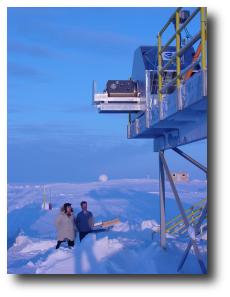|
ETL Microwave Instrumentation Featured in IEEE and ARM Articles
March 29, 2005
Contact: Ed Westwater

Results from an ETL-developed instrument and experiment were the basis for
two recent feature publications. Both the instruments and a review article
on Microwave and Millimeter wave Radiometry were featured in the March 2005
Geoscience and Remote Sensing Society newsletter published by the Institute
of Electrical and Electronics Engineers (IEEE).
Featured on the cover of the newsletter is a photo showing ETL's
Ground-based Scanning
Radiometer (GSR) mounted on the "Sky Deck" of the Department of Energy's
(DOE's) Atmospheric Radiation Measurement (ARM) Program research and
ARM Climate Research Facility (ACRF ACRF's research site in Barrow, Alaska,
during the Arctic
Winter Water Vapor Intensive Operational Period (IOP)
conducted March 9-April 9, 2004).
The GSR is a prototype instrument of one to be used in the Arctic for
water vapor measurements on a long term basis within the NOAA SEARCH
program. It was developed by Dr. Al Gasiewski (ETL) and Drs. Marian Klein
and Vladimir Leuski of (CIRES/NOAA-ETL). Later in the issue,
Dr. Ed R. Westwater, an ARM principal investigator from the Cooperative
Institute for Research in the Environmental Sciences (CIRES)/NOAA-ETL and
coauthors provide a comprehensive tutorial on surface-based measurements of
temperature, water vapor, and cloud liquid in the troposphere, and discuss
the latest technologies used to obtain these measurements.
Barrow, is the northernmost point in the United States, and is one of two
Arctic sites (Atqasuk, Alaska, is the other) that make up the ACRF's North
Slope of Alaska locale. The major goal of the Arctic IOP was to demonstrate
that millimeter wavelength radiometers can substantially improve water vapor
observations during the Arctic winter. As presented in the tutorial,
radiometers deployed during the IOP included the GSR (several frequencies
from 50 to 380 GHz), the Microwave Radiometer and the Radiometric Profiler
of ARM (frequencies from 22.235 to 60 GHz) and the Montana State Infrared
Cloud Imager (ICI). Four posters describing results from this experiment
were presented at the 2005 ARM Science Team Meeting, held March 14-18 in
Daytona Beach, Florida. The photo on the GSR mounted on the "Sky Deck" was
also featured on the cover of the program of the ARM Science Team Meeting.
The IEEE is comprised of over 362,000 members in approximately 175 countries. Its members are leading authorities in technical areas ranging from computer engineering, biomedical technology and telecommunications, to electric power, aerospace and consumer electronics, and remote sensing, among others. Through its technical publishing, the IEEE produces 30% of the world's published literature in electrical engineering, computers and control technology. Also contained in the March 2005 Geoscience and Remote Sensing Society newsletter is the “President's Message” from Dr. Gasiewski - the current President of the IEEE Geoscience and Remote Sensing Society.
More Information
|



 ESRL Home |
PSD/ETL Home |
About PSD |
Programs |
Observing Systems |
About Our Transition |
Search |
Staff
ESRL Home |
PSD/ETL Home |
About PSD |
Programs |
Observing Systems |
About Our Transition |
Search |
Staff